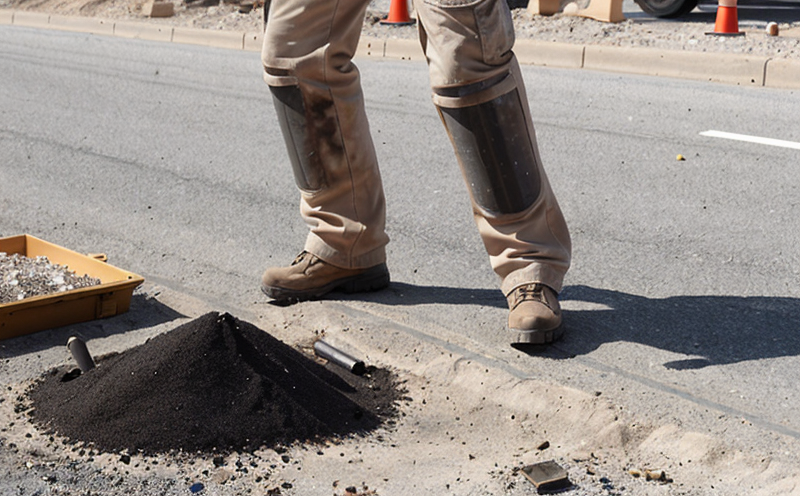DIN 20160 Chemical Stability of Explosives Testing
The DIN 20160 standard is a crucial component in ensuring the safe handling and storage of explosives, particularly in mining operations. This testing method evaluates the chemical stability of explosive materials over time under specified environmental conditions. The primary goal of this test is to determine how long an explosive substance remains stable before it degrades or becomes unsafe for use.
The process involves subjecting samples of explosives to controlled environmental conditions that mimic real-world storage scenarios, such as temperature and humidity levels typical in mining environments. This helps assess whether the product will maintain its integrity throughout its intended shelf life. The test typically lasts for several weeks or months, depending on the specific requirements set by the manufacturer.
During testing, it is essential to follow strict procedures regarding sample preparation. Samples must be cut into standard sizes and shapes according to DIN 20160 guidelines. Additionally, any potential external influences that could affect results—such as light exposure or mechanical damage—are carefully controlled during storage and observation periods.
The use of advanced analytical techniques plays a critical role in interpreting the stability data obtained from these tests. Techniques like Fourier Transform Infrared Spectroscopy (FTIR), High Performance Liquid Chromatography (HPLC), and Gas Chromatography Mass Spectrometry (GC-MS) are often employed to monitor chemical changes within the sample over time.
Once testing is complete, detailed reports summarizing the results of each test run are compiled. These reports provide insights into any observed degradation processes as well as recommendations regarding safe handling practices based on the findings.
Compliance with DIN 20160 standards not only ensures that mining operations adhere to stringent safety regulations but also contributes significantly towards reducing risks associated with improper storage and usage of explosives in hazardous environments like mines. By implementing rigorous testing protocols such as those outlined by DIN 20160, companies can maintain high standards of quality control while safeguarding both personnel health and environmental protection.
For mining companies investing heavily in research & development (R&D), understanding how different factors influence chemical stability is vital for optimizing product performance. Similarly, compliance officers need accurate information about these tests to ensure that all imported or locally produced explosives meet international safety standards. Finally, R&D engineers benefit greatly from knowing what conditions lead to degradation so they can design safer products.
Benefits
The implementation of DIN 20160 chemical stability testing in mining operations offers numerous advantages that contribute directly to improved operational efficiency and safety. One significant benefit is enhanced reliability, which translates into greater confidence among stakeholders about the performance capabilities of explosive materials used during blasting activities.
- Reduced risk of accidents due to unstable explosives
- Increased productivity by minimizing downtime associated with replacing faulty products
- Better resource allocation through accurate forecasting of material needs based on stability data
- Improved reputation among clients who value safety and quality assurance practices
Moreover, compliance with these standards helps mining firms stay ahead in terms of regulatory requirements. This fosters a culture of continuous improvement within the organization while ensuring adherence to industry best practices.
Industry Applications
- Mining: Ensuring safe handling and storage of explosives used during blasting operations.
- R&D: Investigating various factors affecting chemical stability in order to improve product design.
- Procurement: Selecting reliable suppliers who adhere to strict quality control measures.
In addition, this testing method plays a key role in maintaining compliance with international standards such as ISO 17892-3 and EN 14951. These standards provide additional layers of assurance regarding the safety and efficacy of explosives used across diverse industries.
Use Cases and Application Examples
In practice, DIN 20160 chemical stability testing is applied in several ways to ensure optimal performance and safety of explosives. For instance, it can be used during the development phase of new blasting agents to identify potential issues early on before large-scale production begins.
Another common application involves ongoing quality assurance programs where periodic testing ensures that existing products continue meeting specified stability criteria throughout their lifecycle. This is especially important given the dynamic nature of mining environments which may subject explosives to varying degrees of stress over time.
A third example pertains to supplier evaluation processes conducted by purchasing departments. By requiring potential suppliers to demonstrate compliance with DIN 20160 standards, companies can make informed decisions about whom they choose to work with based on proven track records of quality and safety.





